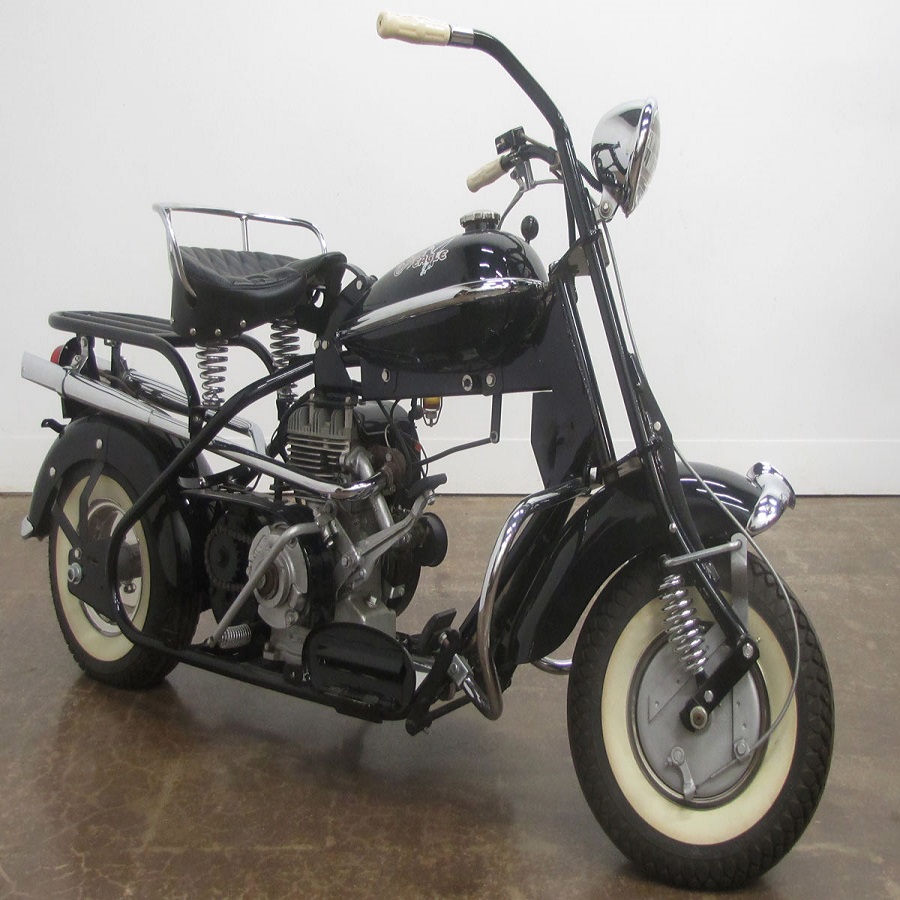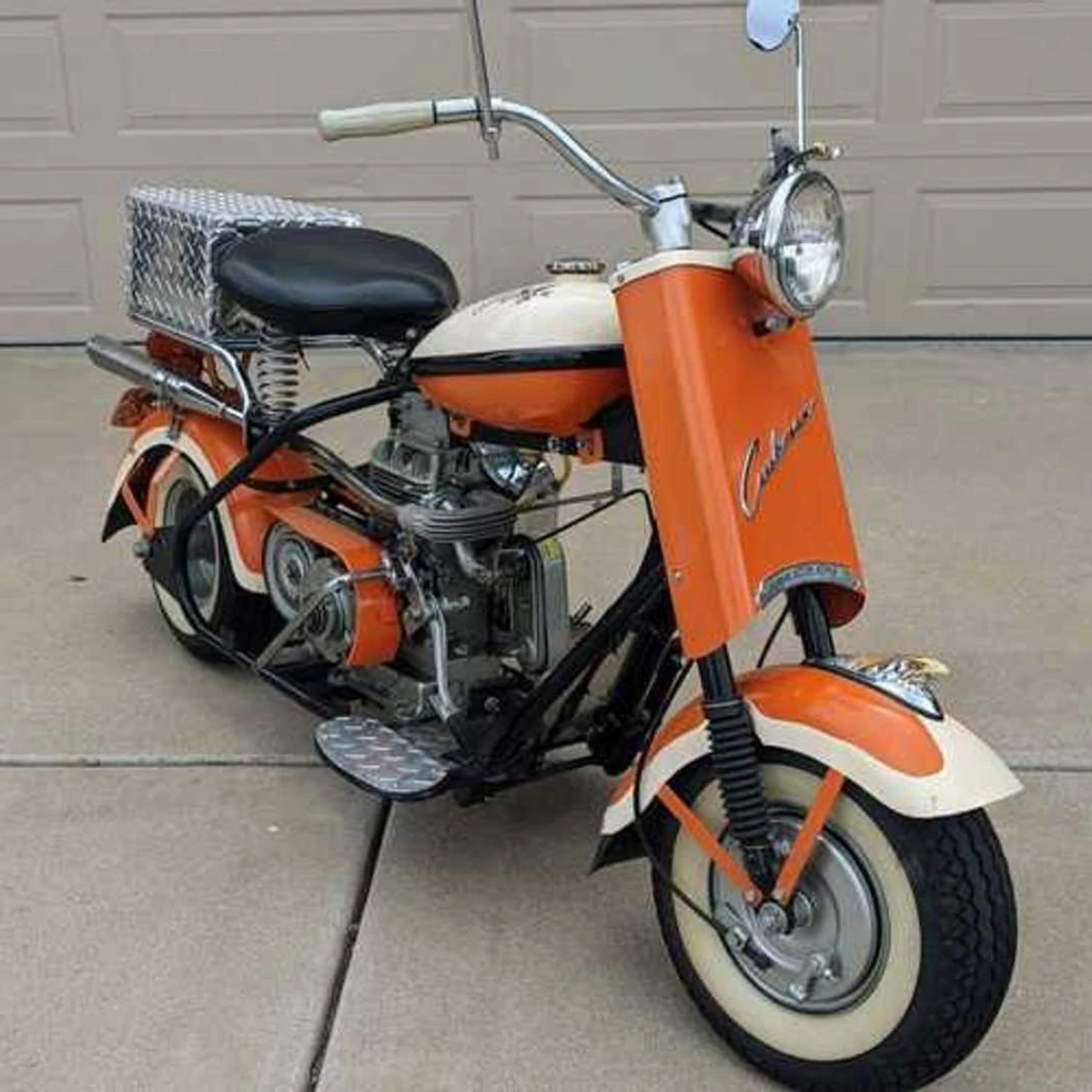Introduction
In the annals of American motorcycle history, few names evoke as much nostalgia and admiration as Cushman. Born out of humble beginnings in Lincoln, Nebraska, the Cushman Motor Works would go on to etch its name in the hearts of enthusiasts as a symbol of resilience, innovation, and the unbridled spirit of adventure that defined mid-century America. More than just a motorcycle manufacturer, Cushman represents a classic era when simplicity, functionality, and durability were the hallmarks of true craftsmanship.

The Birth of a Legend
Cushman’s story begins in 1903 when Everett and Clinton Cushman started a small engine manufacturing company. Initially focused on producing engines for farm equipment and industrial machinery, the company’s pivot to motor scooters and motorcycles in the late 1930s would prove to be a defining moment. Responding to the needs of a nation on the brink of war, Cushman introduced its first scooter, the Model 53, in 1936, aimed at providing efficient transportation for military personnel on base.
Wartime Hero
It was during World War II that Cushman truly came into its own. With gasoline rationing and a need for agile transportation, the U.S. military turned to Cushman for solutions. The rugged and versatile Cushman Model 54 Airborne Scooter, famously known as the “Cushman Colt,” became an integral part of the war effort. Light enough to be dropped by parachute, these scooters were used by paratroopers for reconnaissance missions and rapid troop movement. This wartime service not only showcased the durability of Cushman vehicles but also planted the seeds of their legendary status among returning veterans.
Post-War Boom and Pop Culture Icon
As the war ended and soldiers returned home, Cushman transitioned back to civilian production, capitalizing on the newfound love for freedom and mobility. The 1950s saw the introduction of iconic models like the Eagle and the Super Eagle, which became synonymous with teenage rebellion and the emerging youth culture. These sleek, stylish scooters offered affordable transportation and embodied a sense of freedom and individuality that resonated deeply with young Americans.
Cushman scooters weren’t just a means of getting from point A to B; they were a statement. They featured prominently in movies, television shows, and even music, becoming cultural icons in their own right. Hollywood stars like Steve McQueen were often spotted riding Cushmans, further fueling their popularity and cementing their place in pop culture lore.
Racing Heritage
Beyond their everyday appeal, Cushman motorcycles also made a name for themselves on the race track. Models like the Husky and the Silver Eagle were modified and raced competitively, demonstrating the performance capabilities of these seemingly modest machines. Cushman racers achieved remarkable success, capturing numerous national championships and setting speed records, further enhancing the brand’s reputation for reliability and performance.
Enduring Legacy
Despite ceasing motorcycle production in the 1960s, Cushman’s impact on American motorcycle culture remains profound. Its influence can still be seen in modern custom builds, where vintage Cushmans are meticulously restored or transformed into unique, high-performance machines. Enthusiasts gather at rallies and shows across the country, celebrating the marque’s rich history and sharing stories of restoration projects and thrilling rides.
Cushman’s legacy is more than just metal and engines; it’s about the spirit of an era, the ingenuity of American manufacturing, and the timeless appeal of freedom on two wheels. Each vintage Cushman that roars to life is a testament to the enduring allure of classic American design and the unquenchable thirst for adventure that defines the American spirit. As long as there are roads to ride and hearts that yearn for the open road, the legend of Cushman will continue to inspire and captivate generations to come.

Origins and Early History
Cushman traces its origins back to 1903 when Everett and Clinton Cushman founded the company in Lincoln, Nebraska. Initially known as the Cushman Motor Works, the company started by manufacturing engines for farm equipment and other small machinery. It wasn’t until the early 1930s that Cushman entered the scooter and motorcycle market.
Rise to Prominence
Cushman gained traction during World War II when their scooters became a popular choice for military personnel. Dubbed the “Model 53,” these rugged and reliable scooters were used by the U.S. military for transportation on bases and even for reconnaissance purposes. This wartime experience solidified Cushman’s reputation for durability and performance.
Post-War Innovation and Expansion
After the war, Cushman capitalized on their military success by expanding their lineup to include civilian models. The “Cushman Pacemaker” and “Cushman Eagle” quickly became household names, known for their stylish design, ease of use, and affordability. These scooters were embraced by a wide range of consumers, from urban commuters to suburban families looking for a convenient mode of transportation.
The Golden Era: 1940s-1960s
The 1940s through the 1960s marked Cushman’s golden era, where they dominated the scooter market in the United States. Their scooters were not only practical but also became cultural icons, appearing in movies, advertisements, and even popular music of the time. Cushman scooters were favored for their reliability, low maintenance costs, and distinctive design elements such as the exposed engine and simple handlebar controls.
Diversification and Legacy
Beyond scooters, Cushman also produced motorcycles and three-wheeled vehicles that catered to various consumer needs. Their products ranged from lightweight models suitable for city commuting to more powerful motorcycles designed for longer distances. Cushman’s commitment to quality and innovation earned them a loyal following that persists among collectors and enthusiasts today.
Enduring Popularity and Collector’s Items
While Cushman ceased production of scooters and motorcycles in the 1970s, their legacy continues to thrive. Collectors and hobbyists cherish vintage Cushman models, meticulously restoring them to their former glory. The unique design features, historical significance, and association with American culture make Cushman motorcycles and scooters highly sought after at auctions and vintage vehicle shows worldwide.
Cultural Impact and Recognition
Cushman’s influence extends beyond the realm of motorcycles and scooters. Whether in films depicting mid-century Americana or in museums showcasing industrial design, Cushman motorcycles evoke a sense of nostalgia and admiration for a bygone era.
Legacy of Innovation and Design
In addition to their commercial success, Cushman also contributed to automotive technology and design. Their engineering innovations, such as the Husky engine series and advancements in scooter chassis, set benchmarks for the industry at the time. Cushman’s commitment to craftsmanship and ingenuity paved the way for future generations of motorcycle manufacturers.
The Modern Era and Revival
In recent years, there has been a resurgence of interest in Cushman motorcycles and scooters among collectors, historians, and vintage vehicle enthusiasts. The preservation of these iconic machines ensures that future generations can appreciate Cushman’s legacy and the role they played in shaping American motorcycling culture.

Cultural Iconography and Impact
Beyond their mechanical prowess, Cushman motorcycles and scooters embedded themselves deeply into American cultural iconography. They were not just modes of transportation but symbols of a particular era—a time when mobility, independence, and innovation were paramount. The distinct aesthetic of Cushman vehicles, with their exposed engines, minimalist design, and chrome accents, became emblematic of mid-20th century American style.
The Role in Post-War America
In the post-war era, Cushman played a crucial role in shaping everyday life for many Americans. Their scooters provided an affordable and practical means of transportation during a period of economic recovery and suburban expansion. From delivering mail in urban areas to zipping around newly built suburbs, Cushman vehicles became ubiquitous sights on American streets.
Conclusion
Cushman motorcycles and scooters are more than just vehicles—they are symbols of American innovation, craftsmanship, and cultural heritage. From their origins in Nebraska to their prominence on city streets and military bases worldwide, Cushman embodies the spirit of adventure, freedom, and reliability that defines the American motorcycle experience. As we look back on their storied history, one thing remains clear: Cushman will forever hold a special place in the hearts of enthusiasts as a classic American motorcycle legend.

Leave a Reply